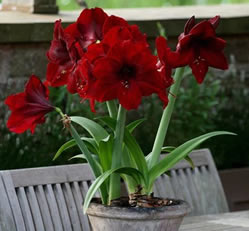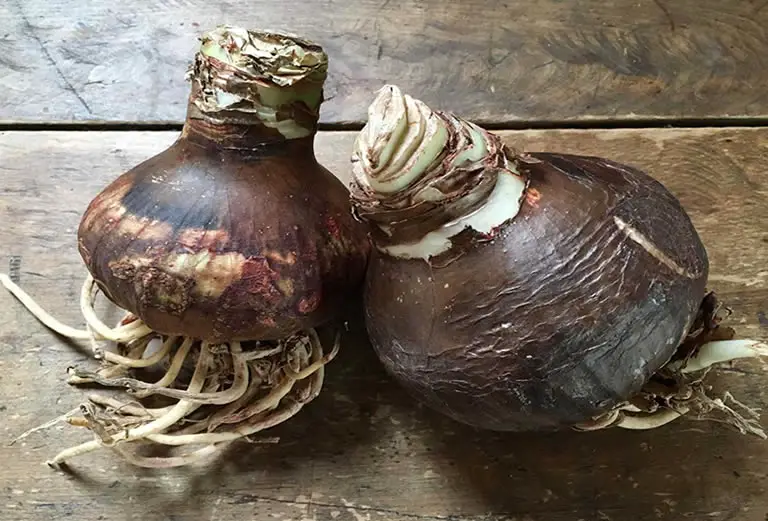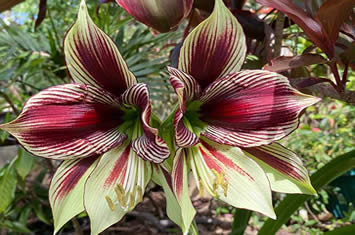Amaryllis is a popular houseplant in the USA and is even grown outdoors in some states but what about growing this beautiful succulent in the UK … is it even possible? In this article I will outline the do’s and don’ts for growing amaryllis in the UK.
Table of Contents
Amaryllis And UK Plant Cultivation
Right off the bat I should point out that most amaryllis plants in the UK are not actually amaryllis plants at all nor are they lilies.
Amaryllis is a tropical succulent that is native to South Africa.
It has only 2 varieties, Amaryllis Belladonna and Amaryllis Paradisicola.
However, as I have previously outlined on this website, most amaryllis bulbs sold in both the USA and the UK are not actually amaryllis plants but are species belonging to the genus Amaryllidaceae.
One of the most popular types of plant that is sold as amaryllis in the UK, but that is not technically speaking an amaryllis, is Hippeastrum.
While amaryllis proper is tropical, being native to South Africa, hippeastrum is subtropical growing naturally in parts of Central and South America.
Amaryllis and hippeastrum are not the same plants but because they look similar, and require similar care, both plants are commonly known as amaryllis.
While amaryllis proper has only 2 species, Hippeastrum has much more variety with 90 species and over 600 cultivars in the genus.
So there is plenty of choice when it comes to common amaryllis.

For example, summer hippeastrum blooms come in almost every color you can think of while varieties of red and white hippeastrum, like these, are very popular in the UK as a Christmas flower.
This is due in part to the festive-colored flowers of the plant. And also in part because the growth stages of amaryllis can be manipulated to ensure a houseplant produces a Christmas bloom every year. There are instructions for doing that available here.
So, because there are many varieties of succulents sold as amaryllis, and because hippeastrum is commonly sold in the UK as amaryllis, from this point forward I will refer to both the tropical species of amaryllis and the common varieties of subtropical Amaryllidaceae, as amaryllis.
All of these “amaryllis” plants are perennials that require similar care and they will bloom each year over many decades if cared for properly.
Can amaryllis be grown outdoors in the UK?
Amaryllis is a succulent that requires warm temperatures to grow.
Your choice of amaryllis will be either as a tropical or subtropical plant and each requires plenty of indirect sunlight and lots of heat.
So, from the start we can see that there may be challenges when it comes to growing amaryllis in the cold, windy UK climate, but can it be done?
Some varieties of amaryllis can be grown outdoors in the UK but only with caution.
As tropical and subtropical plants amaryllis grow best in temperatures between 21° – 32°C.
They do not grow well in temperatures below 15°C and frost will kill them.
So, amaryllis grown outside in the UK will require winter protection.
It is be best to remove the bulb entirely from the soil and store it indoors during the colder months.
Obviously growing a tropical or subtropical plant in the temperate climate of the UK is going to be challenging, if not downright impossible.
However, some species of amaryllis are half hardy perennials that will survive outside in the UK as long as they are given a certain amount of protection.
In all parts of the UK amaryllis will grow happily outdoors in the warmer summer months.
UK temperatures vary, with warmer areas in the south of England and colder areas in the north of Scotland. But all areas of the UK usually experience sufficient summer heat to allow amaryllis to thrive outdoors in the warmer months.
Of course this also applies to Ireland which has a similar climate to the UK.
It is the autumn and winter that pose the most problems for outdoor amaryllis in the British Isles.
Having said that, it is still possible to have outdoor amaryllis in the UK as long as you are willing to give the plant the added attention it will need from the British weather.
Let’s take a look at how you can grow amaryllis outside in the UK in both pots and as a garden plant.
Potted outdoor amaryllis in the UK
Although most amaryllis plants will be grown as a houseplant in the UK it is possible to move the plant outside in the summer months.
It is a common practice for amaryllis owners in the USA to move their potted plants outside when early spring has passed and the onset of summer is imminent.
This is a practice that is becoming more common in the UK as amaryllis owners discover the benefits of giving their houseplants some fresh air.

I know people in Ireland who actually keep separate amaryllis plants for indoor and outdoor use by stagnating the blooming of the plants.
They grow some plants for an indoor winter bloom while they keep others for a summer bloom.
They will move their summer-blooming potted amaryllis outdoors in early summer, about mid-late May, and bring it back indoors when temperatures begin to dip in early-mid September.
Be aware that if you intend to leave your amaryllis outdoors after August then you may want to bring it in at night to protect it, as night temperatures can dip to 10°C at this time of year.
And, never leave your potted amaryllis outside when temperatures go below 10°C or you risk losing your plant.
Garden planted amaryllis in the UK
Uk garden-grown amaryllis require a little more attention than your normal garden plant and require a lot more attention than a potted indoor amaryllis or even a potted outdoor amaryllis.
Where you can simply pick up a potted plant and move it to a more ideal environment, amaryllis growing in the garden is in a set environment.
The same rules apply to using amaryllis outdoors in the UK that apply to using amaryllis outside in the USA.
As a tropical or subtropical plant your amaryllis will grow best in temperatures between 21° – 32°C.
Thus it will happily grow outdoors in the warmer summer months.
Obviously, with freezing winter temperatures in all parts of the UK, amaryllis will not fair well if left in the ground during the winter.
In fact, when temperatures start to decline close to 15°C in late summer/early autumn you should really think about removing an amaryllis bulb from the ground.
Then either store the bulb, for reuse next summer, or pot it for indoor use over the winter.
There are some amaryllis owners, who live in UK areas where the winter is not as severe as the UK average, who will leave their amaryllis in the ground over the winter.
I do not advise doing this however as heavy rain and low temperatures may be infrequent during British winters but they do happen.
Be aware also that those UK residents who live their amaryllis outside year round provide winter protection for the bulb during the cold winter months, and also give it added protection in the late autumn and early spring when frost is a possibility.
So, how do you remove and store an amaryllis bulb for the winter when you have been growing it outdoors over the summer?
Can you keep an amaryllis bulb in the UK?
Keeping an amaryllis bulb safe during the colder UK months is essential if you want to keep a plant that blooms every year for decades.
You can keep an amaryllis bulb in the UK for reuse as long as you keep it indoors in a cool, but not cold, environment.
You can store the bulb in a dimly lit dry area to keep it dormant or simply leave it in its pot indoors.
A potted amaryllis bulb will still go dormant if left potted as long as you do not stimulate new growth.

Amaryllis requires at least 2 months of dormancy so the bulb can rest and gather resources for its next growth cycle.
Unlike many other plants amaryllis does not need darkness to go dormant.
This means you can leave the bulb in its original pot after blooming has finished, and as long as you do not water it or add fertilize to it.
How to keep an amaryllis bulb in the UK
How do you keep an amaryllis bulb in the UK for reuse?
A dormant amaryllis bulb can be kept indoors in its original pot until new growth starts, when it should be repotted.
Alternatively, the bulb can be removed from the soil and placed on kitchen roll or newspaper and stored in a dimly lit room, preferably at temperatures between 12° – 15°C.
Many people wonder what to do with their amaryllis bulb after it has bloomed. Some people mistakenly think the plant is dead and dispose of the bulb. This is a mistake.
Amaryllis is a perennial that blooms once every year. It simply sheds all its foliage for a few months in order to rest.
It is important to allow an amaryllis bulb to rest.
Although it is possible to force an amaryllis plant to rebloom I strongly urge you not to do this.
Constantly forcing the plant to enter and exist dormancy and to rebloom more than once per year will stress the bulb.
Amaryllis can live for many decades if given the simple care they need.
I know of outdoor plants in the states that have been around since the 1950s but if you overwork your amaryllis bulb you will be lucky to have a plant that last even a few years.
To allow an amaryllis bulb to rest all you have to do is let the plant do its own thing. Amaryllis does not need darkness in order to go dormant so it can left be left alone in its own pot to rest.
Once the plant has finished blooming the leaves will begin to turn yellow and die. Eventually all foliage will drop off the bulb.
When you begin to see a yellowing of the leaves, (see this article), you will know that the bulb is preparing to go dormant.
At this point you should stop watering the plant and should not add any more fertilizer, as these actions will prevent the bulb from resting and force it into a new growth cycle.
You can read more information about storing an amaryllis bulb here. Although that article is tailored towards American plant owners the information is equally applicable to UK amaryllis growers.
Can amaryllis be grown indoors in the UK?
With all the challenges involved with growing amaryllis outdoors in the UK does this mean that amaryllis can’t be grown indoors in the UK?
Amaryllis makes a great indoor houseplant in the UK.
It grows best in temperatures between 21° – 32°C which falls into the temperature range for a typical UK home in both summer and winter.

Be aware that even though this succulent makes for a great indoor plant in the UK, amaryllis is poisonous to both humans and pets.
So if you have inquisitive toddlers or curious pets that like to munch on houseplant leaves this many not be the best plant for you to grow.
Planting an indoor amaryllis outdoors in UK summers
The great thing about amaryllis is that you can easily replant it when its dormancy is coming to an end.
When amaryllis starts to enter the dormant phase its leaves will turn yellow and begin to fall off.
Eventually the only part of the plant that remains is the bulb. When it enters a new growth stage sprouts will begin to form from the bulb.
When new growth starts to sprout from the top of the bulb, you can repot or replant the bulb. This means you can take a potted amaryllis, or a dormant bulb, and replant it in the garden in late spring or early summer.
When the summer comes to an end you can simply remove the bulb from the soil and repot it for indoor use or store it for use next year.
The great thing about amaryllis is that it is possible to regulate the growth cycle of the bulb.
This means you can cultivate your plant to ensure it is dormant during late winter and enters a new growth cycle in late spring for a summer bloom.
This means you can plant the bulb outside in the garden to enjoy its flowers during the summer.
For instructions on regulating the growth and blooming cycle of amaryllis read this.
How do you care for an amaryllis plant in the UK?
Although amaryllis grown outdoors in the UK requires a lot of attention due to the climate of the area, indoor amaryllis is an easy-care succulent that requires very little attention compared to many other houseplants.

Below is a quick bullet list of the steps you need to follow to look after your UK amaryllis plant.
12 steps to a healthy UK amaryllis plant:
- Repot the bulb in fresh potting soil when it enters a new growth cycle – when an amaryllis bulb leaves a state of dormancy new sprouts will appear.
- Water the bulb generously but ensure you do not drench the soil.
- Place the amaryllis in a bright and warm area but away from too much direct sunlight.
- Temperatures between 21° – 32°C are ideal for amaryllis during its growth cycle.
- Water the plant regularly, ensuring the soil remains damp but not waterlogged. Only the top layer of soil (2 – 3 cm) should be allowed to dry out.
- When stalks and buds appear fertilize the amaryllis every 2 – 3 weeks using a nutrient-rich liquid feed, like one of these.
- When blooming has finished allow the bulb to rest.
- Do not water or fertilize the plant when you start to see a yellowing of the leaves.
- The bulb can be left in its pot unattended until new growth starts again after 2 – 3 months.
- Alternatively, you can remove the bulb and store it on kitchen roll in a cool dimly lit environment until new growth starts.
- When new sprouts appear repot the amaryllis in fresh potting mix and begin a regular watering routine.
Water and light are very important to an amaryllis when it is in its growth stage. As are nutrients. A lack of nutrients in the soil, along with too much or too little water and/or incorrect temperatures and lighting can lead to an amaryllis plant drooping or falling over.
Amaryllis foliage is mostly leaves and it is through the leaves that you can tell just everything you need to know about the health of your plant. Read my article on amaryllis leaves here for more information on that.
When do amaryllis flower in the UK?
Amaryllis will flower naturally in spring in its native environment.
But when growing amaryllis in the UK when can you expect it to flower?
Amaryllis will usually flower in late winter or early spring in the UK.
However, it is possible to cultivate indoor amaryllis to flower at any time during the year.
This means not only can you have amaryllis that blooms when you want it to but you can also have multiple amaryllis, all with different bloom times, for continual amaryllis flowers all-year-round.
Amaryllis follows an 8 – 12 week growth cycle from dormancy to bloom.
By regulating the environment in which amaryllis grows it is possible to make your plant bloom at a specific time of the year.
Many amaryllis owners cultivate their plant to bloom for Christmas, the reason for it having the names Christmas Flower and Christmas Plant, but you can actually get the plant to bloom in any season or month you choose.

